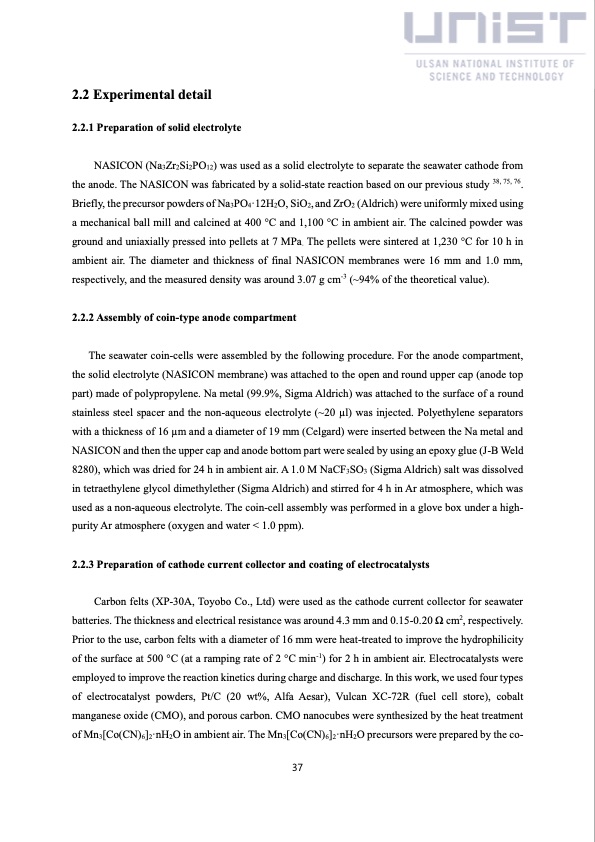
PDF Publication Title:
Text from PDF Page: 042
2.2 Experimental detail 2.2.1 Preparation of solid electrolyte NASICON (Na3Zr2Si2PO12) was used as a solid electrolyte to separate the seawater cathode from the anode. The NASICON was fabricated by a solid-state reaction based on our previous study 38, 75, 76. Briefly, the precursor powders of Na3PO4·12H2O, SiO2, and ZrO2 (Aldrich) were uniformly mixed using a mechanical ball mill and calcined at 400 °C and 1,100 °C in ambient air. The calcined powder was ground and uniaxially pressed into pellets at 7 MPa. The pellets were sintered at 1,230 °C for 10 h in ambient air. The diameter and thickness of final NASICON membranes were 16 mm and 1.0 mm, respectively, and the measured density was around 3.07 g cm-3 (~94% of the theoretical value). 2.2.2 Assembly of coin-type anode compartment The seawater coin-cells were assembled by the following procedure. For the anode compartment, the solid electrolyte (NASICON membrane) was attached to the open and round upper cap (anode top part) made of polypropylene. Na metal (99.9%, Sigma Aldrich) was attached to the surface of a round stainless steel spacer and the non-aqueous electrolyte (~20 μl) was injected. Polyethylene separators with a thickness of 16 μm and a diameter of 19 mm (Celgard) were inserted between the Na metal and NASICON and then the upper cap and anode bottom part were sealed by using an epoxy glue (J-B Weld 8280), which was dried for 24 h in ambient air. A 1.0 M NaCF3SO3 (Sigma Aldrich) salt was dissolved in tetraethylene glycol dimethylether (Sigma Aldrich) and stirred for 4 h in Ar atmosphere, which was used as a non-aqueous electrolyte. The coin-cell assembly was performed in a glove box under a high- purity Ar atmosphere (oxygen and water < 1.0 ppm). 2.2.3 Preparation of cathode current collector and coating of electrocatalysts Carbon felts (XP-30A, Toyobo Co., Ltd) were used as the cathode current collector for seawater batteries. The thickness and electrical resistance was around 4.3 mm and 0.15-0.20 Ω cm2, respectively. Prior to the use, carbon felts with a diameter of 16 mm were heat-treated to improve the hydrophilicity of the surface at 500 °C (at a ramping rate of 2 °C min-1) for 2 h in ambient air. Electrocatalysts were employed to improve the reaction kinetics during charge and discharge. In this work, we used four types of electrocatalyst powders, Pt/C (20 wt%, Alfa Aesar), Vulcan XC-72R (fuel cell store), cobalt manganese oxide (CMO), and porous carbon. CMO nanocubes were synthesized by the heat treatment of Mn3[Co(CN)6]2·nH2O in ambient air. The Mn3[Co(CN)6]2·nH2O precursors were prepared by the co- 37PDF Image | China solar seawater battery

PDF Search Title:
China solar seawater batteryOriginal File Name Searched:
solar-seawater.pdfDIY PDF Search: Google It | Yahoo | Bing
Product and Development Focus for Salgenx
Redox Flow Battery Technology: With the advent of the new USA tax credits for producing and selling batteries ($35/kW) we are focussing on a simple flow battery using shipping containers as the modular electrolyte storage units with tax credits up to $140,000 per system. Our main focus is on the salt battery. This battery can be used for both thermal and electrical storage applications. We call it the Cogeneration Battery or Cogen Battery. One project is converting salt (brine) based water conditioners to simultaneously produce power. In addition, there are many opportunities to extract Lithium from brine (salt lakes, groundwater, and producer water).Salt water or brine are huge sources for lithium. Most of the worlds lithium is acquired from a brine source. It's even in seawater in a low concentration. Brine is also a byproduct of huge powerplants, which can now use that as an electrolyte and a huge flow battery (which allows storage at the source).We welcome any business and equipment inquiries, as well as licensing our flow battery manufacturing.| CONTACT TEL: 608-238-6001 Email: greg@salgenx.com | RSS | AMP |